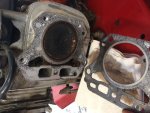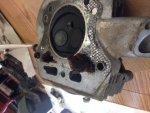I pulled the plug wires to find out which one wasn't firing
Checked the compression: 85psi non-running cylinder / 90psi running cylinder
Checked coils: both making sparks. switched plugs
Popped valve cover: all valves moving
Removed carb and intake pipe: clear of obstructions
I'm not sure how more to trouble shoot this further. The cylinder that was running was very oily and there was oil sputtering out of the coupling between the exhaust pipe and muffler. The carb appears to feed both cylinders (plastic crossover pipe with "T" to the carb) so I think fuel is good. Should I blast a bit of carb cleaner in the dead cylinder?
I've read maybe dropped valve guide. I'm not sure what to look for. When I was manually spinning the crank with the intake off, the live cylinder puffed a bit back up the intake but I forget what position the valves were in.
I've had no trouble with the mower previously and it always starts 1-2 pulls. It started right up on the second pull today, but just ran on 1 cylinder. It is smoking a lot when running (on 1cylinder) like its burning oil.
I replaced a coil a year ago because the ground had corroded. When that happened I would turn the key off and the mower would run on 1 cylinder because one coil wouldn't get grounded. It was not smoking when that was happening.
Thanks in advance.
Checked the compression: 85psi non-running cylinder / 90psi running cylinder
Checked coils: both making sparks. switched plugs
Popped valve cover: all valves moving
Removed carb and intake pipe: clear of obstructions
I'm not sure how more to trouble shoot this further. The cylinder that was running was very oily and there was oil sputtering out of the coupling between the exhaust pipe and muffler. The carb appears to feed both cylinders (plastic crossover pipe with "T" to the carb) so I think fuel is good. Should I blast a bit of carb cleaner in the dead cylinder?
I've read maybe dropped valve guide. I'm not sure what to look for. When I was manually spinning the crank with the intake off, the live cylinder puffed a bit back up the intake but I forget what position the valves were in.
I've had no trouble with the mower previously and it always starts 1-2 pulls. It started right up on the second pull today, but just ran on 1 cylinder. It is smoking a lot when running (on 1cylinder) like its burning oil.
I replaced a coil a year ago because the ground had corroded. When that happened I would turn the key off and the mower would run on 1 cylinder because one coil wouldn't get grounded. It was not smoking when that was happening.
Thanks in advance.


